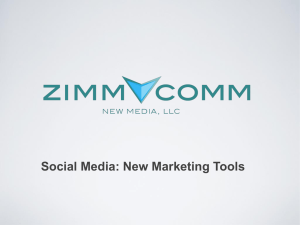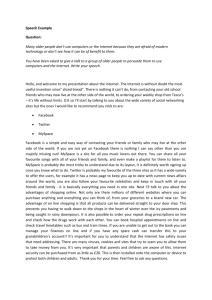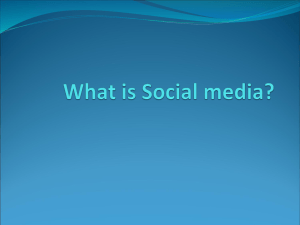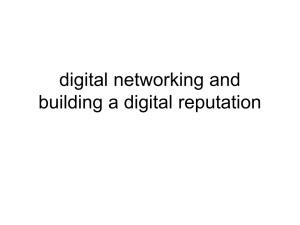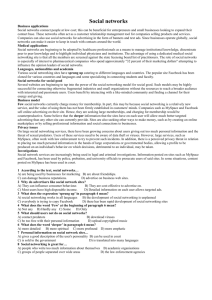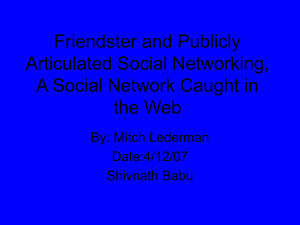Social Network
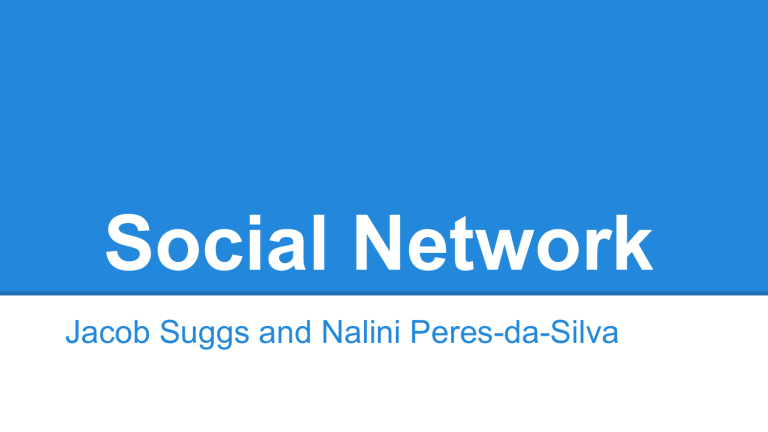
Social Network
Jacob Suggs and Nalini Peres-da-Silva
History and Background
•
Internet sites where people interact freely, sharing and discussing info about each other and their lives, using a multimedia mix of personal words, pictures, videos and audio.
•
1969: CompuServe was the first major commercial internet provider for the US, using dialup connection
•
1988: Internet Relay Chat introduced
•
1991: World Wide Web released to the public
•
1997: First instant messenger (AOL)
•
2002: Friendster (first big social network site)
•
2003: MySpace
•
2004: Facebook
•
2006: Twitter
•
2011: Social networks available on most any device
1969: CompuServe
•
CompuServe used a dialup connection to fulfill the company’s goal to provide in-house internet to people that were part of Golden United Life
Insurance.
1988: Internet Relay Chat Introduced
•
Protocol for live, interactive Internet text messaging or synchronous conferencing.
•
Designed for group communication in discussion forums (channels), also allowing for one-one communication via private message.
1991: World Wide Web Released to Public
•
After being in development for many years, the World Wide Web was introduced in
1991, which set a course for development of social networks on this medium.
1997: First Instant Messenger (AOL)
•
Instant messaging and presence computer program.
•
Used OSCAR and TOC instant messaging protocol to allow registered users to communicate in real time
2002: Friendster (first big social network site)
•
Friendster was the first popular social networking site that brought people together from different geographical areas. It launched a series of other popular social networking sites.
•
In 2011, it was repositioned into a social gaming site.
2003: Myspace
•
Social networking service with a strong music emphasis.
•
Owned by Specific Media LLC and JUSTIN
TIMBERLAKE!
•
Peaked from 2005-2008 as most visited social networking site..
2004: Facebook
•
Started as a “hot or not” game for Harvard students.
•
Is currently being used by over 1 billion people.
2006: Twitter
•
Originally an idea to connect groups of people through
SMS text messaging, Twitter was introduced in 2006 as a social networking site that has competed with
Facebook for years.
•
More celebrities personally use Twitter.
2011: Social Networks Available on Virtually Any Device
•
After many years of development since the rise of social networks and mobile devices, social networking is now available on virtually any device.
Effects on Technology
•
Inspires technological innovation.
•
Now we can access social networks from any device like iPhone, Android,
Blackberry, tablet, laptop, desktop, etc.
•
Affects society because personal popularity can be based on popularity within a social networking site, which would not be possible without technology
(iPhones and laptops in class).
Population & Effects on society
•
98% of 18-24 yr olds using social networks.
•
Total number of Facebook users: 1.4 billion (about
⅕ of population).
•
190 million tweets per day.
•
Average amount of time person spends on social network per month: 15 hours 33 minutes.
•
One out of every seven minutes is spent on a social network site.
Social Networking at a Young Age
•
Every year, more and more children are captivated by social networking.
•
This has been made easier because children are also getting mobile devices at a younger age.
Outcomes of Social Networking
•
Interactions with friends and family, facilitate social and political change, help plan events and activities
•
Greatly dictate peoples lives (specifically in the 18-24 year old range)
•
Pros: quick spread of information, law enforcement uses it to catch and prosecute criminals, make new friends and improve relationships.
•
Cons: enables spread of unreliable information, lack privacy and expose users to government/corporate intrusions, take up large chunk of time and harm job stability.
Cycle of Social Network Popularity
•
Different sites are “in” throughout time- sites become popular and peak, then decline when another one comes into the show.
o o o
Friendster became popular, than MySpace came along.
MySpace became popular, then Facebook came along.
Facebook became popular (still is), then Twitter took
(only some) popularity.
Creation
•
Every successful social networking site has come from one person or a few people with an idea.
•
One thing remember is ideas do not have to start big
.
http://www.youtube.com/watch?v=VSKoVsHs_Ko
An Idea Can Come From Few People
• Friendster: Jonathan Abrams
• MySpace: Tom Anderson and Chris
DeWolfe
• Facebook: Mark Zuckerberg
• Twitter: Jack Dorsey, Evan Williams, Biz
Stone, and Noah Glass
Friendster: Jonathan Abrams
• Founded by computer programmer Jonathan Abrams in a small California town.
• Friendster was based on the "Circle of Friends" (social network) technique for networking individuals in virtual communities and demonstrates the small world phenomenon.
• Friendster had one solid year of rapid success, until it was replaced by MySpace in 2004 in popularity.
MySpace: Tom Anderson and Chris DeWolfe
• These two Friendster employees decided to take popular features from that website and make their own site called MySpace with a group of programmers.
• This site rose quickly to popularity and to avoid being taken down, Chris DeWolfe wanted to purchase
Facebook but rejected Zuckerberg’s $75 million asking price.
• Because of this, Facebook took over as the top social networking site in 2005.
Facebook: Mark Zuckerberg
• Originally started as a “hot or not” website comparing different Harvard undergraduate females, Facebook rose quickly to popularity.
• In 2008, it was declared the most popular social networking site, and it still is today.
• Today Facebook has over 1 billion users.
• Although it is still the most popular, Twitter has taken some of Facebook’s popularity and now the two are competitors.
Twitter: Jack Dorsey, Evan Williams, Biz Stone, and Noah Glass
• Jack Dorsey, a NYU undergraduate at the time, introduced an idea of SMS text messaging to a group of people.
• The others were board members of a podcasting company called Odeo, and they helped Dorsey develop his idea and make it successful.
• Today Twitter has over 500 million users and is the second most popular social networking site, competing with
Facebook.
• It is referred to as “the SMS of the Internet.”
Creation
•
Since every social networking site is a website, each one starts with code.
•
The programmer writes all the code to make the site run and look visually appealing.
Development
•
After the programmer writes the code, the business side of the site comes in.
•
A businessman is needed to find investors and advertisers that will fund the site and help generate revenue.
Where Does The Money Come From?
•
Investments from venture capitalists.
o Ex: Accel Partners has given Facebook 12.7 million dollars.
•
Utilize web advertising.
o
Ex: mobile ads make up 41% of it’s 1.6 billion dollar second quarter ad revenue.
Development
•
Every successful social network site has two components: programming and business.
o The programmer does all the code and behind-the-scenes work on the site.
o The businessman finds investors and finds out to make revenue for the site.
o These two components must be used perfectly together or a site can become uncool and not reach its full potential.
http://www.youtube.com/watch?v=dU6scly2AFU
Appeal
•
Appeal is essential to having a successful social network. There are two types of appeal necessary: visual and social.
o o
The site has to be visually appealing or no one will visit it.
The site also has to keep up with current social trends, or no one will think it is cool enough to visit
(Remember: target age is 18-24).
Sell or Continue?
• As shown by Friendster and MySpace, if you have a popular social network, it will not stay that way.
• Because of this, the decision has to be made: sell or continue?
• Sometimes continuing works, like for Facebook and Twitter for now; but for most, like Friendster and MySpace, continuing does not work and selling was the better option.
Six Steps to Having a Powerful Social Network
1. Start with an idea.
2.
Put the idea into action and test out the site’s popularity.
3. Once popularity is gained, find a businessman who can help gain revenue.
4. Gain investors to gain revenue for the company.
5. Make changes based on what users want.
6. Either sell or ride it out.
But No Matter What, Social Networking is a Business http://www.youtube.com/watch?v=551kYG2m yoU
Social Networking Is Taking Over
http://en.wikipedia.org/wiki/List_of_social_net working_websites
